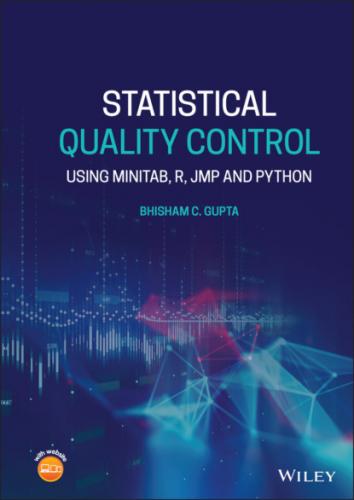Statistical Quality Control. Bhisham C. Gupta
thoroughly reviewed the text to make sure it is as error‐free as possible. However, any errors discovered will be listed on the book’s website: www.wiley.com/college/gupta/SQC.
If you encounter any errors as you are using the book, please send them to me at [email protected] so that they can be corrected in a timely manner on the website and in future editions. I also welcome any suggestions for improvement you may have, and I thank you in advance for helping me improve the book for future readers.
Acknowledgments
I am grateful to the following reviewers and colleagues whose comments and suggestions were invaluable in improving the text:
Dr. Bill Bailey, Kennesaw State University
Dr. Raj Chikkara, Professor Emeritus, University of Houston
Dr. Muhammad A. El‐Taha, Professor of Mathematics and Statistics, University of Southern Maine
Dr. Sandy Furterer, University of Dayton, Ohio
Dr. Irwin Guttman, Professor Emeritus of Statistics, SUNY at Buffalo and Univ. of Toronto
Dr. Ramesh C. Gupta, Professor of Statistics, University of Maine
Dr. Kalanka P. Jayalath, University of Houston
Dr. Jamison Kovach, University of Houston
Dr. Eric Laflamme, Associate Professor of Statistics, Plymouth State University
Dr. Mary McShane‐Vaughn, Principal, Partner‐University Training Partners
Dr. Daniel Zalewski, University of Dayton, Ohio
Dr. Weston Viles, Assistant professor of Mathematics and Statistics, University of Southern Maine
I would like to thank George Bernier (M.S. Mathematics, M.S. Statistics), who is a lecturer in mathematics and statistics at the University of Southern Maine. He provided assistance in the development of material pertaining to R and also helped by proofreading two of the chapters.
I would also like to express my thanks and appreciation to Dr. Eric Laflamme, Associate Professor of Mathematics and Statistics at Plymouth State University of New Hampshire, for helping by proofreading five of the chapters. Last but not least, I would also like to thank Mark W. Thoren (M.S. Electrical Engineering, staff scientist at Analog Devices) for providing assistance in the development of material pertaining to Python. Finally, I would like to thank Dr. Mary McShane‐Vaughn, Principal at University Training Partners, for providing Chapter 2 on Lean Six Sigma. Her concise explanation of the subject has helped give context to why we must monitor the variability of processes to achieve and sustain improvements.
I acknowledge Minitab® for giving me free access to Minitab version 19 and allowing me to incorporate the Minitab commands and screenshots in this book. Minitab® and the Minitab logo are registered trademark of Minitab. I also thank the SAS Institute for giving me free access to JMP Pro‐15 and allowing me to incorporate the JMP commands and screenshots in this book. JMP® and SAS® are registered trademarks of the SAS institute in the United States and other countries. I would also like to thank all the contributors to the libraries of R version 3.6.0 and Python version 3.7.
I would like to gratefully thank my family and acknowledge the patience and support of my wife, Swarn; daughters, Anita and Anjali; son, Shiva; sons‐in‐law, Prajay and Mark; daughter‐in‐law, Aditi; and wonderful grandchildren, Priya, Kaviya, Ayush, Amari, Sanvi, Avni, and Dylan.
Bhisham C. Gupta
About the Companion Website
This book is accompanied by a companion website:
www.wiley.com/go/college/gupta/SQC
The companion websites include:
Chapter 10 (instructor and student sites)
SQC Data Folder (instructor and student sites)
PowerPoint Files (instructor site only)
Instructors’ Solution Manual (instructor site only)
Students’ Solution Manual (student site only)
1 Quality Improvement and Management
1.1 Introduction
Readers of this book have most likely used or heard the word quality. The concept of quality is centuries old. Many authors have defined quality, and some of these definitions are as follows:
Joseph M. Juran defined quality as “fitness for intended use.” This definition implies that quality means meeting or exceeding customer expectations.
W. Edwards Deming stated that the customer's definition of quality is the one that really matters. He said, “A product is of good quality if it meets the needs of a customer and the customer is glad that he or she bought that product.” Deming also gave an alternative definition of quality: “A predictable degree of uniformity and dependability with a quality standard suited to the customer.”
Philip B. Crosby defined quality as “conformance to requirements, not as ‘goodness' or ‘elegance.'” By conformance, he meant that the performance standard must be zero defects and not “close enough.” He is known for his concept of “Do it right the first time.”
The underlying concept in all these definitions is much the same: consistency of performance and conformance with the specifications while keeping the customer's interests in mind.
1.2 Statistical Quality Control
Statistical quality control (SQC) refers to a set of statistical tools used to monitor, measure, and improve process performance in real time.
Definition 1.1
A process may be defined as a series of actions or operations that change the form, fit, or function of one or more input(s) as required by a customer. A process may also be defined as a combination of workforce, equipment, raw material, methods, and environment that work together to produce a product. Figure 1.1 shows various steps that usually take place in any process, whether in a manufacturing or non‐manufacturing environment.
The quality of the final product depends on how the process to be used is designed and executed.
The concept of SQC is less than a century old. Dr. Walter Shewhart (1931), working at the Westinghouse Hawthorne plant in Cicero, Illinois, drew the first statistical process control (SPC) chart in 1924. While working at Hawthorne, Shewhart met and influenced W. Edward Deming and Joseph Juran; later, they went on to champion Shewhart's methods. Shewhart, Deming, and Juran are often considered the three founders of the quality improvement movement.
Figure 1.1 Flow chart of a process.
As mentioned above, SQC is a set of statistical tools used to monitor, control, and improve process performance. These essential tools
